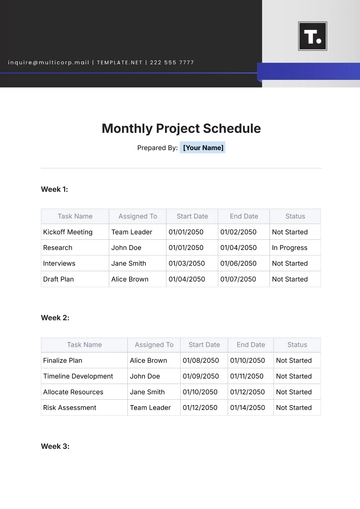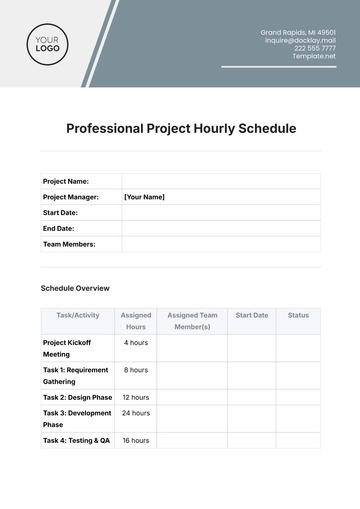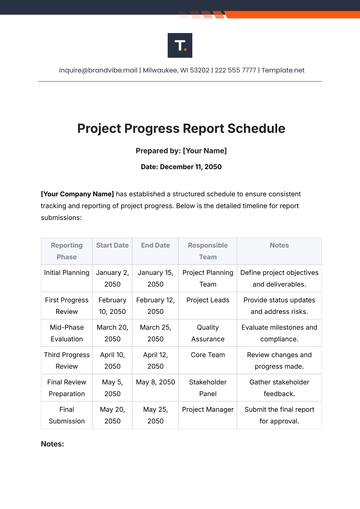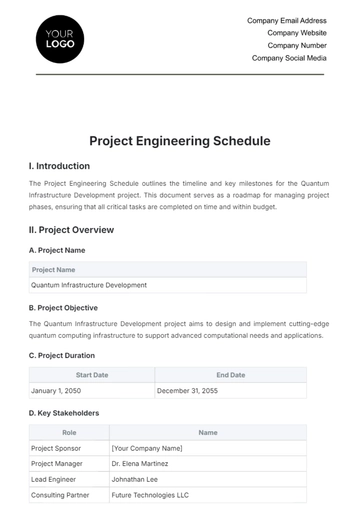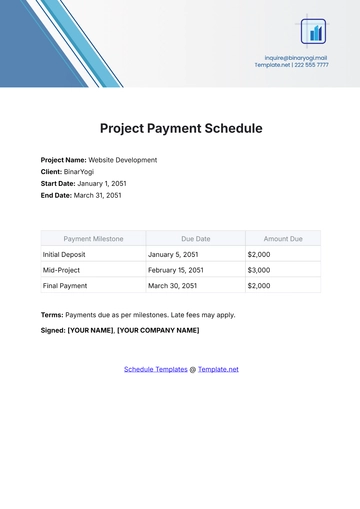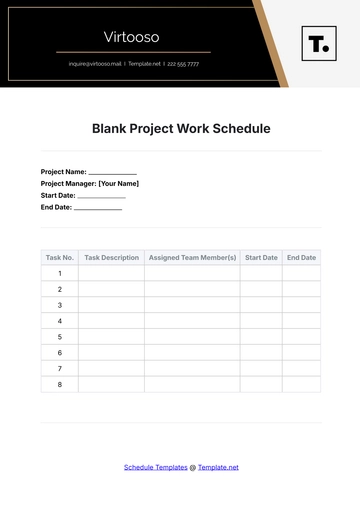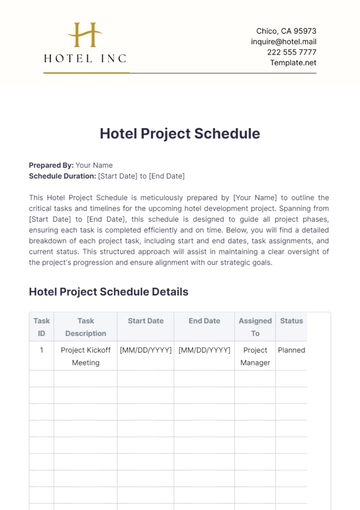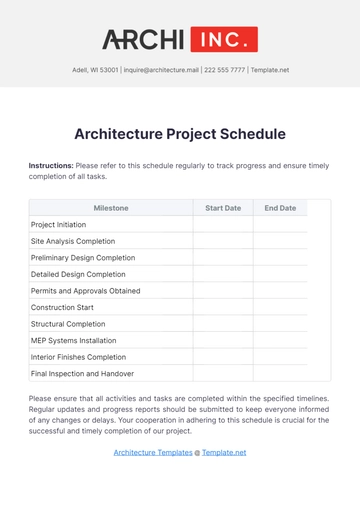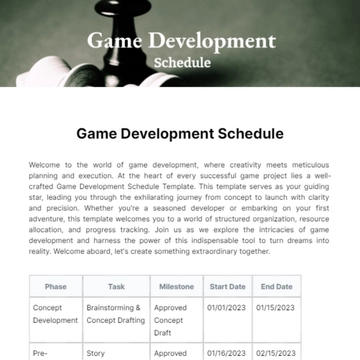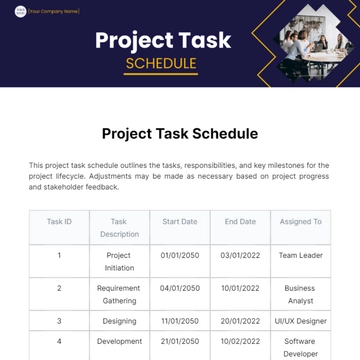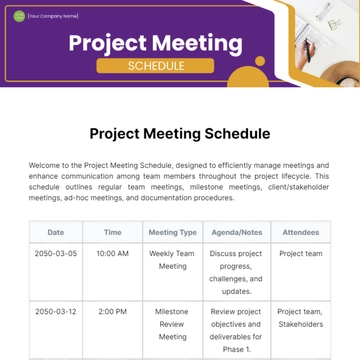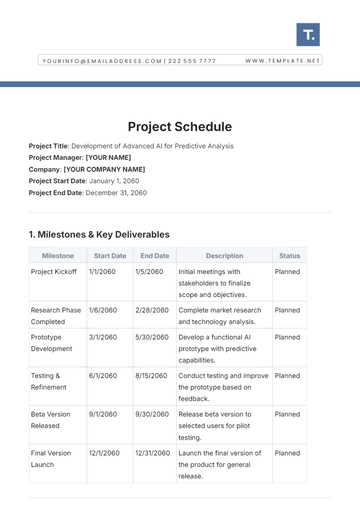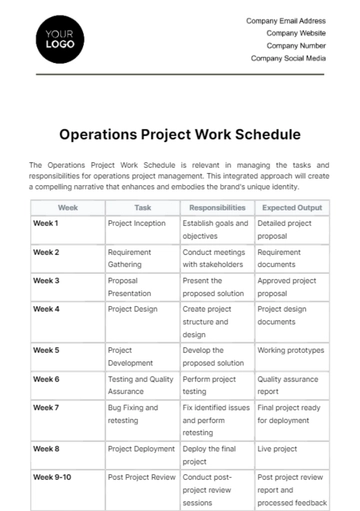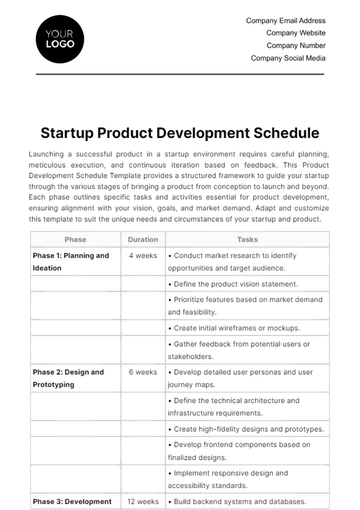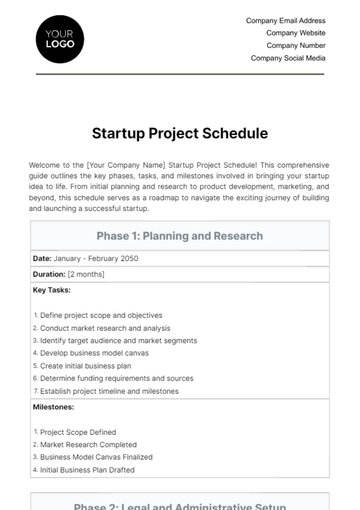Free Operations Project Schedule and Timeline Guide
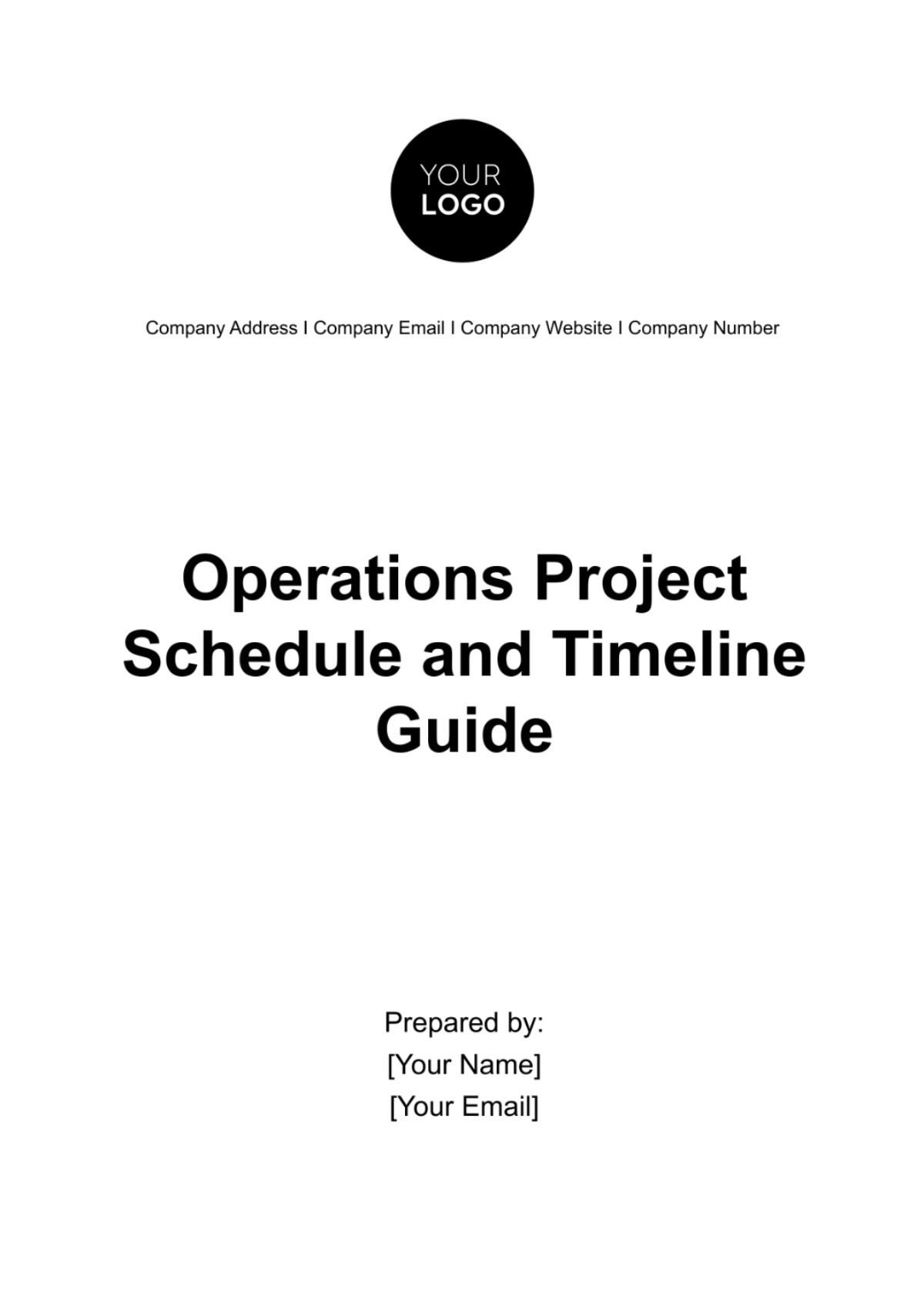
I. Introduction
A. Purpose
The purpose of this document is to provide a comprehensive guide for creating and managing the operations project schedule and timeline for the implementation of a new Customer Relationship Management (CRM) system at [Your Company Name], a leading provider of [Your Company's Industry] solutions. This CRM system implementation project is critical to modernizing our customer management processes and enhancing our ability to deliver personalized services and support to our clients. By establishing a clear project schedule and timeline, we aim to ensure efficient project execution and timely delivery of the CRM solution, ultimately driving improved customer satisfaction and business performance.
B. Scope
This guide is applicable to the CRM system implementation project at [Your Company Name], which aims to streamline customer data management, improve customer service, and enhance overall operational efficiency. It encompasses all phases of the project lifecycle, from initiation to closure, and provides guidance for project managers, IT professionals, department heads, and stakeholders involved in planning, executing, and monitoring the CRM implementation project. The scope of this guide includes defining project objectives, identifying stakeholders, establishing the project team, developing the project schedule, monitoring progress, addressing issues, and conducting project closure activities.
II. Project Initiation
A. Define Project Objectives
The primary objectives of the CRM system implementation project at [Your Company Name] are as follows:
Centralize customer data across all departments to ensure consistency and accuracy.
Improve customer communication and engagement through targeted marketing campaigns and personalized interactions.
Increase efficiency in sales and marketing processes by providing real-time access to customer information and sales data.
Enhance reporting and analytics capabilities for better decision-making and strategic planning.
B. Identify Stakeholders
Stakeholders involved in the CRM system implementation project include:
Executive Leadership: Providing strategic direction and approval for the project, ensuring alignment with overall business goals.
Project Sponsor: Serving as the primary advocate for the project, securing resources and support from senior management.
Project Manager: Overseeing day-to-day activities, managing resources, and ensuring project deliverables are met on time and within budget.
IT Department: Responsible for system configuration, integration with existing systems, data migration, and ongoing maintenance and support.
Sales and Marketing Teams: End-users of the CRM system, providing input on requirements, participating in user acceptance testing, and receiving training on system usage.
Customer Service Department: Providing feedback on customer data management needs, participating in system testing, and receiving training on customer service workflows.
External Vendors: Providing CRM software solutions, technical expertise, and support services throughout the implementation process.
C. Establish Project Team
The project team for the CRM system implementation project consists of the following members:
Project Manager: [Your Name]
Responsibilities:
Overall project oversight, including planning, execution, and monitoring.
Stakeholder communication and reporting.
Risk management and issue resolution.
IT Lead: [IT Team Member]
Responsibilities:
System configuration and customization.
Data migration and integration with existing systems.
Technical support and troubleshooting.
Sales Representative: [Sales Team Member]
Responsibilities:
Providing input on sales processes and requirements.
Participating in user acceptance testing.
Receiving training on CRM system usage.
Marketing Specialist: [Marketing Team Member]
Responsibilities:
Providing input on marketing campaigns and customer segmentation.
Participating in user acceptance testing.
Receiving training on CRM system usage.
Customer Service Manager: [Customer Service Team Member]
Responsibilities:
Providing input on customer service workflows and requirements.
Participating in system testing and validation.
Receiving training on customer service module of the CRM system.
III. Project Planning
A. Develop Work Breakdown Structure (WBS)
The Work Breakdown Structure (WBS) for the CRM system implementation project at [Your Company Name] is outlined below:
Task ID | Task Description | Responsible Party | Duration (Days) | Dependencies |
|---|---|---|---|---|
1 | Project Initiation | Project Manager | 5 | None |
1.1 | Define Project Scope and Objectives | Project Manager | 2 | None |
1.2 | Identify Stakeholders | Project Manager | 1 | 1.1 |
1.3 | Establish Project Team | Project Manager | 2 | 1.1 |
B. Estimate Time and Resources
Estimating time and resources for each task in the WBS involves collaboration among project team members and consideration of factors such as task complexity, resource availability, and project constraints. The project manager, in consultation with team leads and subject matter experts, should assign realistic durations and resource allocations to each task based on their expertise and experience.
C. Define Milestones
Key milestones for the CRM system implementation project include:
Project Kickoff Meeting: Scheduled for [Date] to officially launch the project and align stakeholders.
Requirements Sign-off: Expected by [Date] to finalize the project requirements and scope.
System Design Completion: Targeted for [Date] to complete the customization and integration plan.
User Acceptance Testing (UAT): Scheduled for [Date] to validate the CRM system functionality.
Go-Live: Planned for [Date] to officially launch the CRM system and transition to live operations.
IV. Schedule Development
A. Create Project Schedule
The project schedule is developed using project management software such as Microsoft Project or Asana. It includes the following components:
Task List: A detailed list of all project tasks derived from the WBS.
Task Durations: Estimated durations for each task based on resource availability and dependencies.
Dependencies: Relationships between tasks indicating task sequence and dependencies.
Resource Assignments: Allocation of resources to each task based on availability and expertise.
Timeline: A visual representation of the project schedule, including start and end dates for each task and milestone.
B. Establish Timeline
The timeline for the CRM system implementation project is as follows:
Project Start Date: | [Start Date] |
Project End Date: | [End Date] |
Duration: | [Duration] |
Milestones: | Key project milestones and their scheduled dates. |
C. Validate Schedule
The project schedule is validated through review and approval by key stakeholders, including the project sponsor, executive leadership, and department heads. Any necessary adjustments or refinements are made based on stakeholder feedback to ensure alignment with project objectives and constraints.
D. Resource Allocation
Resource allocation involves assigning specific team members to tasks based on their skills, availability, and workload. The project manager collaborates with department heads and team leads to ensure that resources are allocated effectively to meet project deadlines and deliverables. Regular monitoring of resource utilization helps identify any resource constraints or overallocations that need to be addressed to maintain project efficiency.
V. Project Execution
A. Monitor Progress
Monitoring progress involves tracking the completion of project tasks, identifying any deviations from the project schedule, and addressing issues or risks that may impact the project timeline. The project manager regularly updates the project status and communicates progress to stakeholders through status reports and meetings. Progress is tracked using project management software, which allows for real-time visibility into task completion and resource utilization.
Task ID | Task Description | Status | Actual Start Date | Actual End Date | Comments |
|---|---|---|---|---|---|
1 | Project Initiation | Completed | [Date] | [Date] | - |
2 | Requirements Gathering | In Progress | [Date] | [Date] | - |
3 | System Design | Not Started | [Date] | [Date] | - |
4 | Development | Not Started | [Date] | [Date] | - |
B. Address Issues
Addressing issues involves identifying and resolving any challenges or obstacles that arise during project execution. The project manager leads efforts to mitigate risks, allocate additional resources if necessary, and adjust the project schedule as needed to ensure timely completion. A dedicated issue tracking system is used to log and prioritize issues, assign ownership, and track resolution progress.
C. Communicate Updates
Communicating updates involves providing regular updates to stakeholders on project progress, including any changes to the project schedule, milestones, or deliverables. Clear and transparent communication helps maintain stakeholder engagement and alignment throughout the project lifecycle. Communication channels include email updates, project status meetings, and stakeholder workshops.
VI. Project Closure
A. Evaluate Performance
Evaluating performance involves conducting a post-project review to assess the success of the CRM system implementation project and identify areas for improvement. Key performance metrics such as project duration, budget adherence, and stakeholder satisfaction are analyzed to determine project success. Lessons learned sessions are conducted with the project team to gather feedback and insights for future projects.
Metric | Target | Actual | Variance |
|---|---|---|---|
Project Duration | 180 days | 175 days | -5 days |
Budget Adherence | $200,000 | $195,000 | -$5,000 |
Stakeholder Satisfaction | Scale: 1-5 | 4.5 | +0.5 |
B. Document Results
Documenting results involves capturing lessons learned, best practices, and recommendations for future projects. A project closure report is prepared to summarize project outcomes, highlight successes and challenges, and provide insights for continuous improvement. The report includes detailed analyses of project performance metrics, as well as recommendations for optimizing project processes and methodologies.
C. Celebrate Success
Celebrating success involves recognizing and thanking the project team and stakeholders for their contributions to the CRM system implementation project. A project completion ceremony or team gathering may be organized to acknowledge achievements and foster team morale. Certificates or awards may be presented to team members in recognition of their outstanding performance and dedication.
VII. Risk Management
A. Identify Risks
Identifying risks involves systematically identifying potential threats or opportunities that may impact the successful completion of the CRM system implementation project. Risks can include technical challenges, resource constraints, stakeholder resistance, and external factors such as regulatory changes or market shifts. Risk identification is conducted through brainstorming sessions, expert interviews, and historical data analysis. A Risk Register is maintained to document identified risks, their potential impact, and proposed mitigation strategies.
B. Assess and Prioritize Risks
Assessing and prioritizing risks involves analyzing the likelihood and potential impact of each identified risk to determine its level of priority. Risks are evaluated based on criteria such as severity, likelihood of occurrence, and potential mitigation strategies. This process helps in focusing resources and attention on addressing the most critical risks first. Risk assessment techniques such as qualitative and quantitative analysis are used to assign risk scores and prioritize mitigation efforts.
C. Develop Risk Response Strategies
Developing risk response strategies involves formulating proactive measures to mitigate or address identified risks and minimize their impact on the project. Response strategies may include risk avoidance (eliminating the risk altogether), risk mitigation (reducing the probability or impact of the risk), risk transfer (shifting the risk to a third party), or risk acceptance (accepting the consequences of the risk). The project manager collaborates with the project team and stakeholders to develop and implement appropriate risk response plans. Contingency plans are also developed for high-impact risks to minimize disruptions to project progress.
VIII. Continuous Improvement
A. Lessons Learned
Lessons learned involves capturing and documenting insights, best practices, and areas for improvement identified during the CRM system implementation project. Lessons learned sessions are conducted with project team members and stakeholders to reflect on project successes and challenges, analyze root causes of issues, and identify opportunities for process optimization and innovation. A Lessons Learned Report is prepared to document key findings, recommendations, and action items for future projects.
B. Implementing Process Improvements
Implementing process improvements involves integrating lessons learned and identified opportunities for improvement into ongoing project management practices and organizational processes. Action plans are developed to address key areas for improvement, with clear objectives, timelines, and responsible parties assigned for implementation. Continuous feedback mechanisms are established to monitor the effectiveness of process improvements and ensure ongoing refinement and optimization. Regular reviews and audits are conducted to assess the impact of implemented improvements and identify further areas for enhancement, thereby fostering a culture of continuous improvement within the organization.
IX. Conclusion
The successful implementation of the CRM system at [Your Company Name] is contingent upon meticulous planning, diligent execution, and proactive risk management. By adhering to the comprehensive project schedule and timeline outlined in this guide, we aim to ensure the timely delivery of the CRM solution while maintaining alignment with project objectives and stakeholder expectations.
Throughout the project lifecycle, effective communication, collaboration, and continuous monitoring of progress will be paramount. Regular updates will be provided to stakeholders to ensure transparency and foster trust in the project's progress.
Moreover, by implementing robust risk management strategies, we will be able to anticipate and mitigate potential challenges, thereby minimizing disruptions to project timelines and ensuring successful outcomes.
- 100% Customizable, free editor
- Access 1 Million+ Templates, photo’s & graphics
- Download or share as a template
- Click and replace photos, graphics, text, backgrounds
- Resize, crop, AI write & more
- Access advanced editor
Efficiently manage your operations projects with the Operations Project Schedule and Timeline Guide Template from Template.net. This editable and customizable guide provides a structured approach to planning and executing projects, ensuring timely completion and resource optimization. With our Ai Editor Tool, tailor the schedule and timeline to your project's unique requirements. Streamline your operations and drive success with this comprehensive template.
You may also like
- Schedule Appointment
- Work Schedule
- Weekly Schedule
- Cleaning Schedule
- Payment Schedule
- School Schedule
- Maintenance Schedule
- Daily Schedule
- Class Schedule
- Workout Schedule
- Event Schedule
- Marketing Schedule
- Weekly Cleaning Schedule
- Work From Home Schedule
- Payroll Schedule
- Restaurant Schedule
- Kitchen Cleaning Schedule
- Schedule of Values
- Hourly Schedule
- Study Schedule
- University Schedule
- Construction Schedule
- Preventive Maintenance Schedule
- Fitness Schedule
- Education Schedule
- Training Schedule
- Agency Schedule
- Panel Schedule
- Monthly Schedule
- Nursing Home Schedule
- Project Schedule
- Real Estate Schedule
- Freelancer Schedule
- Medication Schedule
- IT and Software Schedule
- Interior Design Schedule
- Travel Schedule
- Travel Agency Schedule
- Hotel Schedule
- Wedding Schedule
- Camp Schedule
